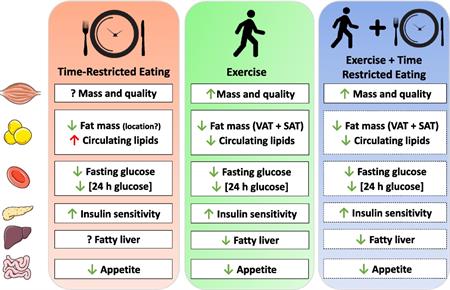Diba Mani, Ph.D. |
June
7, 2021
With the recognition of the Exercise and Sport Sciences Reviews (ESSR) 2020 Paper of the Year designation (congratulations!), Parr, Heilbronn and Hawley’s Perspectives for Progress article, “A Time to Eat and a Time to Exercise,” published in January 2020 should expect to get a few more interactions online. Those who read the article when it first came out may even give it another perusal. In doing so, some of us who are teaching a summer University course or even thinking ahead to next academic year may begin looking for new classroom material and will hopefully consider incorporating a review paper such as this one.
This Perspectives for Progress is an excellent source to consider as an introduction to time-restricted eating (TRE) and the potential impact on circadian biology, especially as a means to limit some of the damaging impact caused by modern human lifestyles (i.e., perpetual access to highly caloric foods and low recurrent physical activity). The article provides insight into the potential complementary effects of exercise and TRE, which encourages longer daily fasting to improve metabolic health.
Specific suggestions for incorporating this paper in the classroom could entail instructors expanding on different diets, especially in a nutrition course, or recognizing the impact of food intake on exercise interventions in a course on exercise prescriptions. Students may be asked to research and present on a “mainstream” diet and then compare their findings to those reported on TRE. Parr and colleagues recognize the significance in timing of food intake, which could be expanded on in the classroom through a lecture on the circadian cycle, a topic I, for one, do not typically cover in my Neuromuscular Aspects of Exercise, Motor Learning or Applied Human Physiology courses but should consider, given the significant role of sleep (or lack of) in exercise and motor skill acquisition and retention (Walker et al. 2002, Walker et al. 2003).
 In lieu of (or in addition to) incorporating a research-based assignment to instill an opportunity for activity learning in the classroom, instructors may opt for a more visual activity, such as through infographic development. Figure 2 in the recognized paper demonstrates the effects of TRE and exercise training on human metabolic health. Students in a classroom may easily develop their own infographics on related topics by using programs such as Canva and AdobeSpark. Instructors may choose to create an infographic themselves, perhaps to aesthetically demonstrate main findings of a paper such as this one.
In lieu of (or in addition to) incorporating a research-based assignment to instill an opportunity for activity learning in the classroom, instructors may opt for a more visual activity, such as through infographic development. Figure 2 in the recognized paper demonstrates the effects of TRE and exercise training on human metabolic health. Students in a classroom may easily develop their own infographics on related topics by using programs such as Canva and AdobeSpark. Instructors may choose to create an infographic themselves, perhaps to aesthetically demonstrate main findings of a paper such as this one.
Unconvinced that this article will fit your course topic or level? Not a problem. Although this winning paper does not currently have an article supplement, others published in ESSR come with freely accessible video abstracts, journal club questions and visual abstracts. Incorporating research articles, especially review papers, is an excellent method to teach students curriculum content while developing their professional research skills and comes highly recommended.
Again, a big congratulations to Evelyn Parr. Ph.D., Leonie Heilbronn, Ph.D., and John Hawley, Ph.D., for the selection of their article as the ESSR 2020 Paper of the Year!
Don’t forget to View the current and previous Paper of the Year selections and editorials covering the selected articles at the ESSR Paper of the Year Topical Collection.
References
Parr EB, Heilbronn LK, Hawley JA. A time to eat and a time to exercise. Exercs. Sport Sci. Rev. 2020; 48(1):4-10.
Walker MP, Brakefield T, Morgan A, Allan Hobson J, Stickgold R. Practice with sleep makes perfect: sleep-dependent motor skill learning. Neuron. 2002; 35(1):205-211.
Walker MP, Brakefield T, Seidman J, Morgan A, Allan Hobson J, Stickgold R. Sleep and the time course of motor skill learning. Learn Mem. 2003; 10(4):275-284.
Diba Mani, Ph.D., is a lecturer in the Department of Applied Physiology & Kinesiology at the University of Florida. She serves as the Digital Editor for Exercise and Sport Sciences Reviews. She earned her degrees under the mentorship of Dr. Roger Enoka in the Neurophysiology of Movement Laboratory at the University of Colorado. Her doctoral dissertation focused on evaluating the effects of electrical nerve stimulation on motor unit discharge properties and mobility in young and older adults. Dr. Mani most enjoys the human component of any work she is engaging in, be it research in the field of geriatrics or teaching college students in the classroom. Dr. Mani is an internationally certified judo referee and coach, and a regular vinyasa yoga practitioner. She is passionate about diversity and cultural promotion through involvement in groups such as Iranian American Academics & Professionals and the Persian Students Organization.